The Czech Republic is home to a wide variety of bird species, from waterfowl to raptors. With its diverse landscape of forests, wetlands, meadows, and grasslands, the country provides a rich habitat for birds of all sizes, shapes, and colors.
From the common Starling to the rare Aquatic Warbler, bird enthusiasts can find a plethora of species to observe and enjoy. With its abundance of bird species, the Czech Republic is an ideal destination for bird watching.
1. Long-Tailed Tit

The Long-tailed tit is a common bird found throughout Europe and the Palearctic. Described by Carl Linnaeus in 1758, it has been given the scientific name Aegithalos caudatus which translates to “long tailed bush-tit”.
These birds are small with white bellies and grey backs. The distinguishing feature of this species is its long tail feathers which give them their name.
They feed on insects such as moths, flies and spiders but also eat seeds from plants like thistles or dandelions.
In cold weather they flock together for warmth while at night they roost inside woodpecker holes or other crevices in trees.
Long-tailed tits build intricately woven nests made of mosses, lichens, spider webs and fur held together by saliva – these can be up to 15 cm wide.Scientific classification:
| Kingdom | Animalia |
| Phylum | Chordata |
| Class | Aves |
| Order | Passeriformes |
| Family | Aegithalidae |
| Genus | Aegithalos |
| Species | A. caudatus |
2. Common Chaffinch

The Common Chaffinch is a beautifully coloured small passerine bird belonging to the finch family.
The males have striking blue-grey caps and rust-red underparts, while the females are more subtle in their colouring but both possess two distinct white wing bars and white sides on their tails.
This gorgeous bird has an incredibly strong voice which can be heard for miles as it sings from exposed perches during mating season.
It lives mainly throughout Europe but also in parts of North Africa and Asia too, favouring woodland areas with plenty of shrubs or trees nearby where they find shelter amongst foliage when needed.
They feed predominantly on seeds from weeds or grains found within grasslands making them particularly useful birds for farmers who rely heavily upon pest control that these little ones provide.Scientific classification:
| Kingdom | Animalia |
| Phylum | Chordata |
| Class | Aves |
| Order | Passeriformes |
| Family | Fringillidae |
| Subfamily | Fringillinae |
| Genus | Fringilla |
| Species | F. coelebs |
3. Common Kingfisher

The Common Kingfisher is a small, sparrow-sized bird that can be found across Eurasia and North Africa. It has the typical short tail and large head of kingfishers with seven different subspecies recognized in its range.
They are mainly resident birds but will migrate away during winter when rivers freeze over. The species usually live near bodies of water such as streams or lakes.
Where they hunt for fish by diving from above into the water after spotting their prey below them.
These brightly coloured birds have an unmistakable vibrant blue plumage along with orange underparts and white patches on their wings which makes them easy to recognize amongst other similar looking species.
Their call is loud and shrill making it one of the most recognizable sounds heard around wetlands throughout Europe.Scientific classification:
| Kingdom | Animalia |
| Phylum | Chordata |
| Class | Aves |
| Order | Coraciiformes |
| Family | Alcedinidae |
| Subfamily | Alcedininae |
| Genus | Alcedo |
| Species | A. atthis |
4. White-Throated Dipper

The White-throated dipper is a small aquatic passerine bird found in Europe, Middle East, Central Asia and the Indian Subcontinent. It has several subspecies that vary mainly by colour differences of their pectoral band.
The species prefers fast flowing rivers with clear water where it can be seen diving underwater to search for food like insects and other invertebrates.
They are known to use pebbles as tools when searching for food under rocks on river beds.
This unique behavior earned them the nickname “Nature’s Stone Mason” from some European countries such as Norway which declared it its national bird due to its iconic status among locals who have been observing this fascinating creature since time immemorial.Scientific classification:
| Kingdom | Animalia |
| Phylum | Chordata |
| Class | Aves |
| Order | Passeriformes |
| Family | Cinclidae |
| Genus | Cinclus |
| Species | C. cinclus |
5. Common Starling
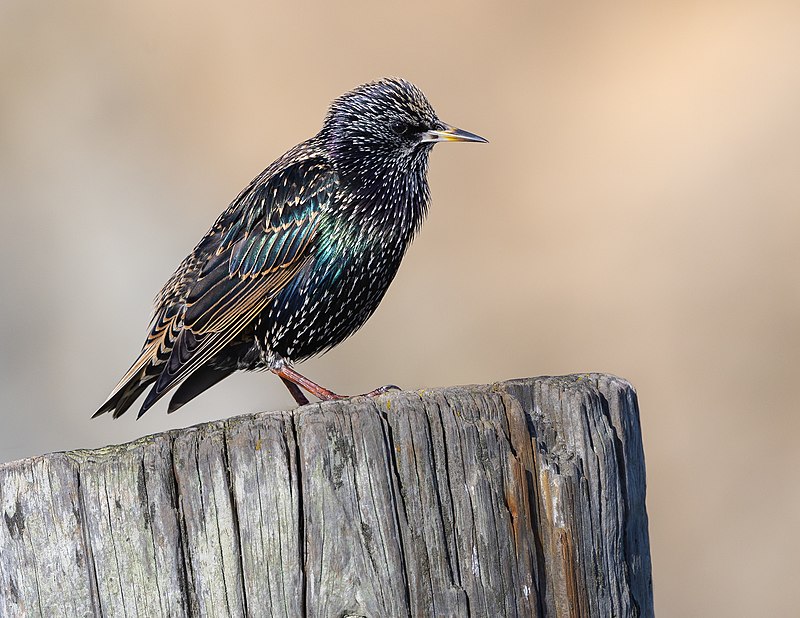
The Common Starling is a medium-sized passerine bird that belongs to the starling family. It has glossy black plumage with a metallic sheen, and in certain times of year it can be speckled with white.
The bill and legs are typically pink or black depending on the season, while its length measures about 8 inches long.
Its diet consists mainly of insects but also includes small fruits and seeds as well as some human food waste.
They live in large flocks which provides protection against predators, although they can become quite aggressive when defending their nesting sites during breeding seasons.
Overall, this species is highly adaptable and widely distributed across many parts of Europe making them one of the most successful birds in the region today.Scientific classification:
| Kingdom | Animalia |
| Phylum | Chordata |
| Class | Aves |
| Order | Passeriformes |
| Family | Sturnidae |
| Genus | Sturnus |
| Species | S. vulgaris |
6. Mistle Thrush

The Mistle Thrush is a beautiful bird that can be found across much of Europe, temperate Asia and North Africa. It has a pale grey-brown upper body, with black spots on its off-white underparts.
Its chin and throat are also whitish in colour. During the winter months northern and eastern populations migrate south but most other birds stay put year round forming small flocks along the way.
These thrushes have strong legs which they use to dig through soil looking for food such as slugs, snails or insects – although they will happily take advantage of fruit when it’s available.
They’re known for their melodious songs that often fill gardens during summertime – making them popular among many gardeners.Scientific classification:
| Kingdom | Animalia |
| Phylum | Chordata |
| Class | Aves |
| Order | Passeriformes |
| Family | Turdidae |
| Genus | Turdus |
| Species | T. viscivorus |
7. Eurasian Blackcap

The Eurasian blackcap is a typical warbler, found across Europe and Asia. It has mainly olive-grey upperparts and pale grey underparts. The male has a striking black cap while the female’s is reddish brown in colour.
Males have an attractive song which is usually a rich musical warbling heard during the breeding season.
Blackcaps are small birds with short tails, long wings, stout bills and large feet – perfect for their insectivorous diet of spiders, beetles and other invertebrates they find as they hop along forest floors or among shrubs.
As well as eating insects they also feed on fruits such as elderberries at certain times of year to gain extra energy reserves before migrating southwards to warmer climates over winter months where food sources may be scarce or harder to find.Scientific classification:
| Kingdom | Animalia |
| Phylum | Chordata |
| Class | Aves |
| Order | Passeriformes |
| Family | Sylviidae |
| Genus | Sylvia |
| Species | S. atricapilla |
8. Fieldfare
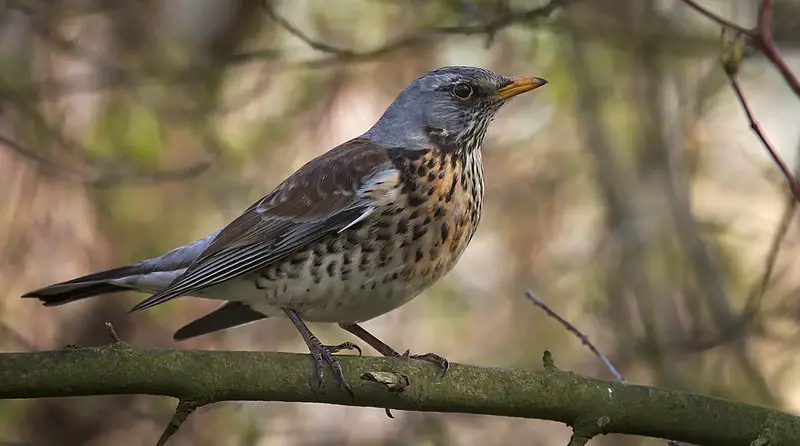
The Fieldfare is a member of the thrush family, known for its vibrant plumage. It breeds in woodlands and scrub across Europe, but it’s a rare breeder in Britain & Ireland.
During winter months it migrates southwards to countries such as North Africa and the Middle East where winters are milder.
The bird has grey-brown upperparts with black spots on its wings and tail feathers; these contrast sharply against its off-white underparts which have orange streaks running along them.
When threatened or startled they give an alarm call that sounds like ‘tchack’. This species feeds mainly on berries from shrubs during autumn and winter before returning to their breeding grounds in springtime.Scientific classification:
| Kingdom | Animalia |
| Phylum | Chordata |
| Class | Aves |
| Order | Passeriformes |
| Family | Turdidae |
| Genus | Turdus |
| Species | T. pilaris |
9. Red-Throated Loon

The Red-throated Loon is a migratory bird found in the northern hemisphere, with its breeding grounds primarily located in Arctic regions and wintering spots near coastal waters.
With an average length of 55 – 67 cm (22 – 26 inches), it’s the smallest member of the loon or diver family.
Its namesake comes from its bright red throat patch which contrasts against its white underside and grey back.
This species has adapted to life on icy seas; they are strong swimmers with powerful wings for long flights over open water when migrating seasonally.
Their diet consists mostly of fish but can also include crustaceans, molluscs, amphibians and insects depending on availability.Scientific classification:
| Kingdom | Animalia |
| Phylum | Chordata |
| Class | Aves |
| Order | Gaviiformes |
| Family | Gaviidae |
| Genus | Gavia |
| Species | G. stellata |
10. Red-Backed Shrike

The Red-backed Shrike is a beautiful member of the shrike family, found in western Europe and central Russia. It is easily identified by its gray mantle, black wings with white spots and red back.
In summer it migrates to eastern tropical Africa or southern Africa where they overwinter.
This bird feeds mainly on insects but also eats small mammals, reptiles and other birds as well as fruit occasionally.
They are known for their hunting techniques which include perching high up in trees then diving down onto their prey below them before returning to eat it at leisure elsewhere.
The Red-backed Shrike is an impressive sight that lives both in our gardens and far away places.Scientific classification:
| Kingdom | Animalia |
| Phylum | Chordata |
| Class | Aves |
| Order | Passeriformes |
| Family | Laniidae |
| Genus | Lanius |
| Species | L. collurio |
11. Little Grebe
Little grebes, also known as dabchicks, are small water birds native to temperate and subtropical regions of Europe, Asia and Africa.
These plump little birds have short necks, round heads with bright eyes and long toes that help them swim through the water rapidly.
Their plumage is dull grey-brown on top and white underneath; they are adorned with a distinctive black stripe across their throats.
In addition to being able to fly well underwater in search of prey such as fish or aquatic insects, these vocal creatures make loud trilling noises both during courtship displays or when defending territory from intruders.
They breed near freshwater bodies like ponds, lakes marshes in reed beds by constructing floating nests using vegetation anchored together with mud collected from the bottom of shallow waters.
Little grebes can often be seen swimming low over the surface of stillwater looking for food – a sight sure to delight any bird lover.
12. Eurasian Bittern

The Eurasian Bittern is a large and secretive wading bird of the heron family. It has two subspecies, one found in Europe and northern Africa, while another can only be seen in parts of southern Africa.
This migratory species spends its winters southwards from its breeding grounds across much of Europe to eastern Asia as far south as China.
The male bitterns are easily identifiable by their loud booming calls that they make during mating season which is usually between April-May.
They have brown striped plumage with lighter underparts which helps them blend into marshy habitats where they feed on fish and amphibians among other prey items.
Despite having a relatively wide distribution range, this species remains threatened due to habitat destruction caused by human activities such as wetland drainage for agricultural use or development projects like dams etc., making conservation efforts necessary for securing their future survival.Scientific classification:
| Kingdom | Animalia |
| Phylum | Chordata |
| Class | Aves |
| Order | Pelecaniformes |
| Family | Ardeidae |
| Genus | Botaurus |
| Species | B. stellaris |
13. Bearded Reedling

The Bearded Reedling is a small passerine bird found in reed-beds across Europe, Asia and North Africa.
It is easily identified by its distinct black and white plumage with males having yellow faces.
This species belongs to the only family of birds known as Panuridae and was first described by Carl Linnaeus back in 1758.
They feed on insects such as beetles, flies, moths among others but also consume seeds from plants like sedges or rushes during winter months when food availability decreases significantly.
These birds are territorial meaning that they have their own area where they live which can vary from 8 to 12 hectares depending on the seasonality of insect abundance within these areas making them an important part for maintaining healthy ecosystems in wetlands around their range.Scientific classification:
| Kingdom | Animalia |
| Phylum | Chordata |
| Class | Aves |
| Order | Passeriformes |
| Family | Panuridae Des Murs, 1860 |
| Genus | Panurus Koch, 1816 |
| Species | P. biarmicus |
14. Water Rail

The Water rail is a member of the Rallidae bird family, which inhabits wetlands with dense vegetation. It has a flattened body to aid it in its wetland habitat; this helps it move through long grass and reeds easily.
Adults measure 23-28 cm (9-11 inches) in length and they can be found throughout Europe, Asia and North Africa.
Northern and eastern populations are migratory whereas southern ones remain permanent residents year round.
The bird’s diet consists mainly of insects, small fish, worms, molluscs as well as some plant material like grains or seeds.
Its feathers have an overall brownish grey colouration while its belly is white or creamy yellow with dark markings around the edges of each feather that gives them camouflage against their environment when seen from above or below water level respectively.Scientific classification:
| Kingdom | Animalia |
| Phylum | Chordata |
| Class | Aves |
| Order | Gruiformes |
| Family | Rallidae |
| Genus | Rallus |
| Species | R. aquaticus |
15. Eurasian Treecreeper
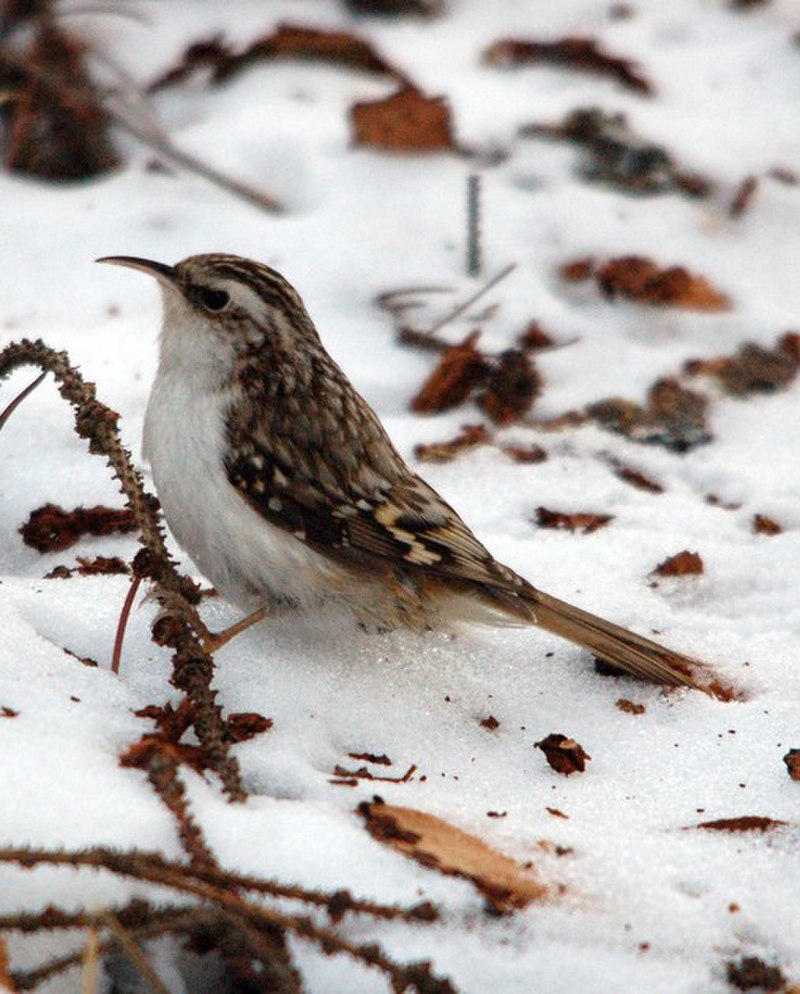
The Eurasian treecreeper is a small passerine bird that can be found in parts of Europe and Asia. It has a curved bill, patterned brown upperparts, whitish underparts and long stiff tail feathers which help it to climb up trees.
This species is the only living member of its genus Certhia familiaris, commonly known as ‘treecreeper’ in Britain.
The treecreepers feed mainly on insects hidden within bark crevices or even underneath mosses. These birds are also very social; they often form large flocks during winters when food becomes scarce.
They have an unmistakable call resembling ‘tsee-ti’, making them quite easy to spot while out exploring nature.Scientific classification:
| Kingdom | Animalia |
| Phylum | Chordata |
| Class | Aves |
| Order | Passeriformes |
| Family | Certhiidae |
| Genus | Certhia |
| Species | C. familiaris |
16. River Warbler

The River Warbler is a small bird in the grass warbler genus Locustella. It can be found breeding in eastern and central Europe, as well as throughout the western Palearctic region.
During winter it migrates to inland Southern Africa from around the Zambezi River all the way down south of Pretoria.
Its name comes from its Latin diminutive “locusta” meaning grasshopper due to its habit of foraging for insects on low vegetation near water bodies like rivers or streams.
This bird has olive-brown upperparts with whitish underparts which have black streaks across them.
These streaked feathers help it blend into its natural habitat making it difficult to spot against reeds and tall grasses growing along riverbanks and wetland areas where they often frequent during migration season looking for food sources such as flying insects or small crustaceans that inhabit those environments.Scientific classification:
| Kingdom | Animalia |
| Phylum | Chordata |
| Class | Aves |
| Order | Passeriformes |
| Family | Locustellidae |
| Genus | Locustella |
| Species | L. fluviatilis |
17. Eurasian Reed Warbler

The Eurasian reed warbler (Acrocephalus scirpaceus) is a species of Old World Warbler native to the temperate parts of Europe and Asia.
It breeds in wetlands such as marshes, ponds and rivers with dense vegetation like reeds or tall grasses.
During its wintering season, it migrates southward to sub-Saharan Africa where there are milder conditions.
This small bird has streaked brown plumage on the upperparts and white underparts which makes it difficult for predators to spot among the foliage.
Its diet consists mainly of insects including aphids, caterpillars larvae and moths caught while flying over water or by gleaning from plants growing near water bodies.
The male sings an attractive song consisting of several phrases repeated one after another as part of their courtship display during breeding season in order attract females for mating purposes.Scientific classification:
| Kingdom | Animalia |
| Phylum | Chordata |
| Class | Aves |
| Order | Passeriformes |
| Family | Acrocephalidae |
| Genus | Acrocephalus |
| Species | A. scirpaceus |
18. Eurasian Penduline Tit
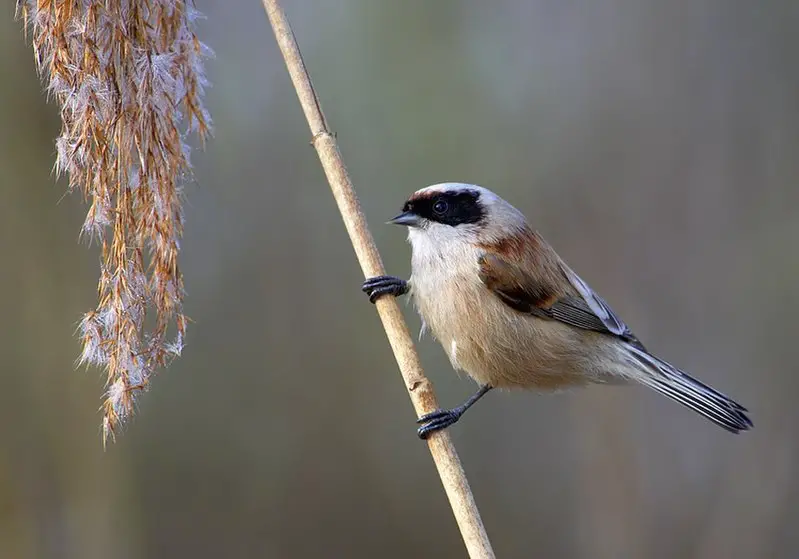
The Eurasian penduline tit is a passerine bird of the genus Remiz which can be found widely across the western Palearctic.
It migrates to more northern parts in summer, while staying resident in its southern range during winter months.
This species experienced an expansion of its breeding grounds throughout Western Europe between 1980s and 1990s, thus increasing its population significantly.
The Penduline Tit has various striking features like bright yellow underparts with black streaks on sides.
Greyish-brown upper part with white underside and pale eye line along head sides as well as distinctive tail nest made from fibers and mosses hanging from trees or shrubs like a pendulum hence their name ‘Penduline’.
These birds feed mainly on insects but also eat some seeds especially sunflower seeds making them popular garden visitors for many people.Scientific classification:
| Kingdom | Animalia |
| Phylum | Chordata |
| Class | Aves |
| Order | Passeriformes |
| Family | Remizidae |
| Genus | Remiz |
| Species | R. pendulinus |
19. Mallard

The Mallard is a species of dabbling duck that can be found living in temperate and subtropical regions across the Americas, Eurasia and North Africa.
It has been introduced to other areas such as New Zealand, Australia, Peru, Brazil and South Africa by humans.
This beautiful bird belongs to the Anatinae subfamily of waterfowl family Anatidae. The adult mallards have a glossy green head with white neck ring surrounding.
It along with brownish grey body feathers making them look stunning when they fly away or just sitting in their natural habitat around lakes or ponds.
They are excellent swimmers too due to webbed feet which helps them swim fast underwater while looking for food like aquatic insects etc.. Their loud quacking sound makes them quite popular among nature lovers.Scientific classification:
| Kingdom | Animalia |
| Phylum | Chordata |
| Class | Aves |
| Order | Anseriformes |
| Family | Anatidae |
| Genus | Anas |
| Species | A. platyrhynchos |
20. Crested Tit

The Crested tit is a beautiful bird found in Europe. It belongs to the family Paridae and its scientific name is Lophophanes cristatus.
This species can be seen mainly in coniferous forests of northern and central Europe, as well as deciduous woodlands of France and the Iberian peninsula.
The most prominent feature of this species is its crest which makes it easily identifiable from other birds in the area. Its diet consists mostly of insects, seeds, berries and nuts – all essential nutrients for their survival.
In Great Britain, they are primarily found inhabiting ancient pinewoods such as Inverness or Straffordshire where you may catch sight of them if you’re lucky.
All-in-all these striking little creatures make an exciting addition to any nature enthusiast’s list – so keep your eyes peeled next time you go out exploring.Scientific classification:
| Kingdom | Animalia |
| Phylum | Chordata |
| Class | Aves |
| Order | Passeriformes |
| Family | Paridae |
| Genus | Lophophanes |
| Species | L. cristatus |
21. Song Thrush

The Song Thrush is a beautiful bird that breeds across the West Palearctic. It has brown upper-parts and creamy or buff underparts with black spots, as well as three recognised subspecies.
Its vocalisations are particularly melodious; its song consists of repeated musical phrases, hence why it has been referenced often in poetry.
This species can be found breeding in forests, gardens and parks during summertime months before migrating elsewhere for winter.
With its attractive plumage and lovely singing voice, it’s no wonder this thrush is so beloved by many.Scientific classification:
| Kingdom | Animalia |
| Phylum | Chordata |
| Class | Aves |
| Order | Passeriformes |
| Family | Turdidae |
| Genus | Turdus |
| Species | T. philomelos |
22. Tufted Duck

The Tufted Duck is a small diving duck which can be found in northern Eurasia, with an estimated population of nearly one million. It gets its scientific name from Ancient Greek and Latin words meaning “sooty throat”.
The adult male has black plumage except for white flanks and a blue-grey bill. Its head is also adorned by the distinctive tufts that give it its common name.
Females are brownish grey on their upper parts and have paler underparts than males as well as having orange bills instead of blue-grey ones like their male counterparts.
This species feed mainly on aquatic plants but will occasionally eat molluscs, crustaceans, insects or worms when they’re available too.
They are generally quite shy birds so keep your distance if you spot them while out in nature to avoid disturbing them unnecessarilyScientific classification:
| Kingdom | Animalia |
| Phylum | Chordata |
| Class | Aves |
| Order | Anseriformes |
| Family | Anatidae |
| Genus | Aythya |
| Species | A. fuligula |
23. Rook

Rooks are a species of black-feathered birds found in the Palearctic region from Scandinavia to eastern Siberia. They have distinctive white, featherless areas on their faces and nest communally in tall trees.
Rooks are social creatures that often forage together for food such as insects, earthworms, seeds and small animals like mice or frogs.
They also enjoy bathing regularly in shallow pools of water and dusting themselves off afterwards with dry soil or sand.
In addition to providing protection against parasites when nesting high up in the treetops, rooks will use communal roost sites during winter nights which can contain thousands of individuals all huddled close together.Scientific classification:
| Kingdom | Animalia |
| Phylum | Chordata |
| Class | Aves |
| Order | Passeriformes |
| Family | Corvidae |
| Genus | Corvus |
| Species | C. frugilegus |
24. Common Pochard

The Common Pochard is a medium-sized diving duck found across Eurasia and North Africa. It has distinctive features such as a long, dark bill with a grey band, red head and neck, black breast, red eyes and grey back.
The female has similar characteristics but her head is more brown/grey in colour than the male’s striking red hue.
They are often seen swimming together in large flocks near freshwater bodies or on lakes to feed on aquatic plants like seeds of waterlilies etc., which makes them an important part of the ecosystem by helping disperse plant species.
Their loud call can be heard over vast distances making them easy to spot even when they’re far away.Scientific classification:
| Kingdom | Animalia |
| Phylum | Chordata |
| Class | Aves |
| Order | Anseriformes |
| Family | Anatidae |
| Genus | Aythya |
| Species | A. ferina |
25. Grey Wagtail

The Grey Wagtail is a beautiful bird species, belonging to the Motacillidae family. It measures 18-19 cm in length and has distinctive black throat markings for breeding males.
Their yellow colouring on their underside extends from the throat to the vent area only. This species can be found across Europe and Siberia during its breeding season before migrating further south towards tropical areas of Asia or Africa.
Its diet consists mainly of insects which it catches with quick movements as it usually hops or flutters around watercourses such as streams, rivers or lakesides – although they are also seen near roads too.
The grey wagtail makes an attractive addition to any garden so why not give them a chance by providing food sources like peanuts and sunflower hearts?Scientific classification:
| Kingdom | Animalia |
| Phylum | Chordata |
| Class | Aves |
| Order | Passeriformes |
| Family | Motacillidae |
| Genus | Motacilla |
| Species | M. cinerea |
Also Featured In: Belarus Birds You Should Know, Moorland Birds You Need to Know
26. Black Woodpecker
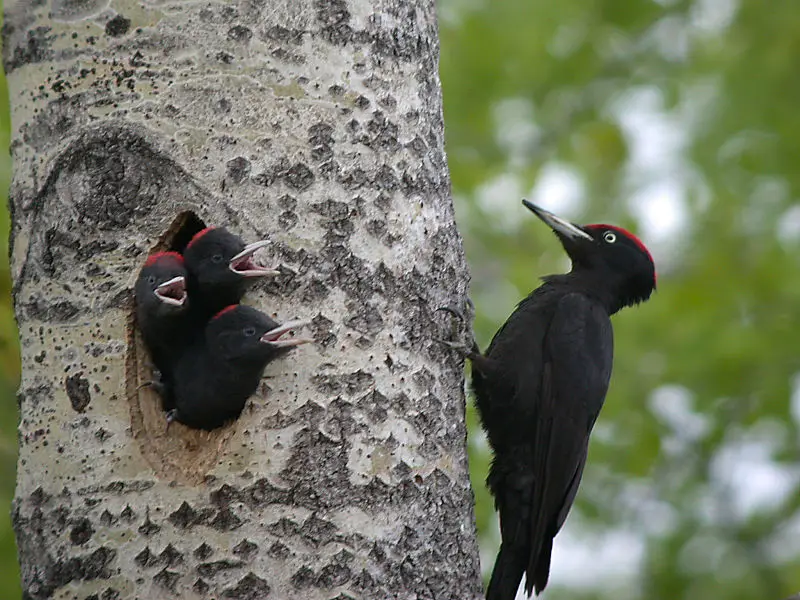
The black woodpecker is an impressive bird found in mature forests across the northern Palearctic region.
It stands out from other species due to its large size and striking black feathers with white spotting on their wings and tail.
Not only is it one of the largest woodpecker species worldwide but also, interestingly, appears to be expanding its range in Europe and Asia as well.
This non-migratory bird loves spending time amongst trees where they can feed off insects which live within tree trunks or branches; tapping away at them with their strong bills until they get a meal.Scientific classification:
| Kingdom | Animalia |
| Phylum | Chordata |
| Class | Aves |
| Order | Piciformes |
| Family | Picidae |
| Genus | Dryocopus |
| Species | D. martius |
27. Bee-Eater

Bee-eaters are one of the most beautiful and vibrant birds in existence. They have a slender body, long wings, down turned bills and their signature elongated central tail feathers which make them instantly recognizable from afar.
Their plumage is incredibly colorful with many shades ranging from blues to greens to reds that glisten when they fly through the air.
These stunning creatures can be found all over Africa, Asia, Southern Europe, Australia and New Guinea where they feed mainly on bees but also other insects like flies or wasps as well as small mammals such as lizards or rodents.
Bee-eaters live in colonies near rivers or wetlands so that they may easily hunt for food while staying close together for safety purposes.
Additionally it allows them to better display their impressive courtship dances during mating season.Scientific classification:
| Kingdom | Animalia |
| Phylum | Chordata |
| Class | Aves |
| Order | Coraciiformes |
| Family | Meropidae Rafinesque, 1815 |
28. Shorebirds

Shorebirds, a diverse group of birds in the Charadriiformes order, are found near water on every continent except Antarctica.
These small to medium-sized birds feed mainly on invertebrates and other small animals but can also be pelagic seabirds or inhabit deserts.
Shorebirds use their long bills to probe mudflats for food like worms and mollusks while some species plunge into the ocean’s depths in search of crustaceans such as crabs and shrimp.
They have strong legs equipped with webbed feet which allow them to move quickly when searching for prey across wetlands, sandbars, beaches and swamps.
Their feathers make them well adapted to life by land or sea due to its hydrophobic nature which helps reduce drag during swimming or flying through windy conditions making it easier for shorebirds survive tough environments around the world.Scientific classification:
| Kingdom | Animalia |
| Phylum | Chordata |
| Class | Aves |
| Infraclass | Neognathae |
| Clade | Neoaves |
| Clade | Gruimorphae |
| Order | Charadriiformes Huxley, 1867 |
29. Sittidae
Little grebes, also known as dabchicks, are small water birds native to temperate and subtropical regions of Europe, Asia and Africa.
These plump little birds have short necks, round heads with bright eyes and long toes that help them swim through the water rapidly.
Their plumage is dull grey-brown on top and white underneath; they are adorned with a distinctive black stripe across their throats.
In addition to being able to fly well underwater in search of prey such as fish or aquatic insects, these vocal creatures make loud trilling noises both during courtship displays or when defending territory from intruders.
They breed near freshwater bodies like ponds, lakes marshes in reed beds by constructing floating nests using vegetation anchored together with mud collected from the bottom of shallow waters.
Little grebes can often be seen swimming low over the surface of stillwater looking for food – a sight sure to delight any bird lover.
30. Sandgrouse
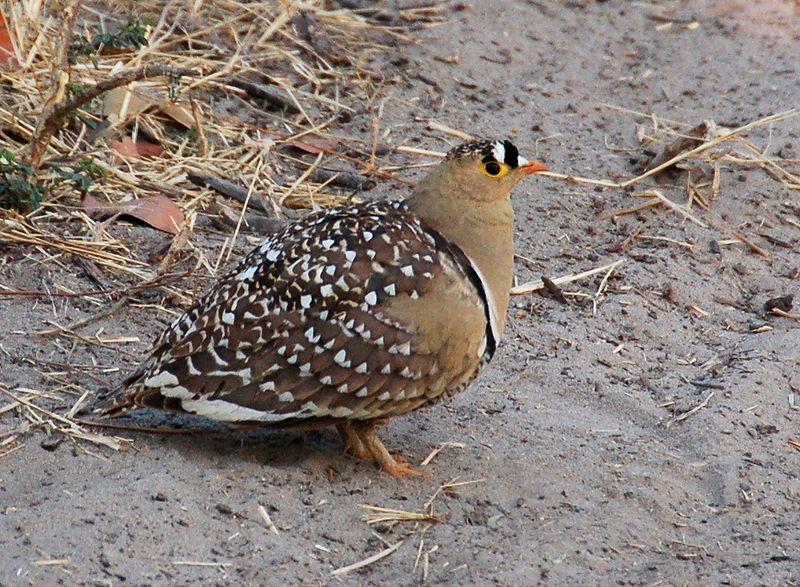
Sandgrouse is birds of the order Pterocliformes, found mainly in Africa and Asia. There are sixteen species belonging to two genera – Syrrhaptes from central Asia and Pterocles from Africa and other Asian countries.
They inhabit treeless areas such as deserts, steppes, scrubland, or savannas and tend to be ground-dwelling birds that feed on seeds.
Sandgrouse has adapted special features for survival in their harsh environment.
They possess well-developed feet with four toes used for walking over hot sand while keeping their body temperature cool at all times by regulating heat loss through their legs.
Their feathers also act like a sponge helping them absorb water before flying long distances back home where they then expel it using specialized glandular secretions located near the wings so that chicks can drink directly from an adult’s breast plumage.Scientific classification:
| Kingdom | Animalia |
| Phylum | Chordata |
| Class | Aves |
| Clade | Columbimorphae |
| Order | Pterocliformes Huxley, 1868 |
| Family | Pteroclidae Bonaparte, 1831 |
31. Cream-Colored Courser
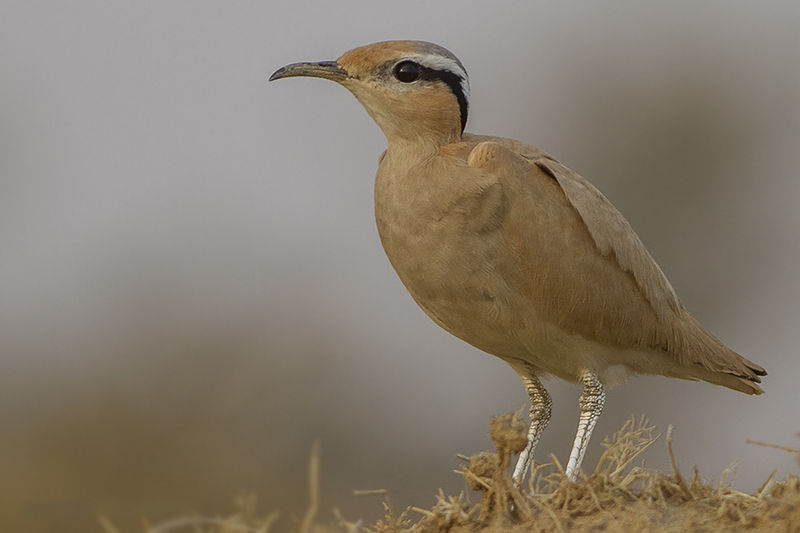
The Cream-colored Courser is a species of wader belonging to the Glareolidae family. It can be found across Western Asia and North Africa and inhabits dry, open semi-desert habitats.
These birds have adapted well to their environment; they are able to run quickly in search of insect prey on the ground which explains their scientific name Cursorius cursor – derived from Latin for ‘runner’.
The coursers also inhabit the Canary Islands as well as Cape Verde where breeding occurs during summer months before migration back south begins in autumn and winter months.
They are easily identified by their distinctive cream coloration with brown streaking along wings, neck and chest region making them an important part of these arid ecosystems.Scientific classification:
| Kingdom | Animalia |
| Phylum | Chordata |
| Class | Aves |
| Order | Charadriiformes |
| Family | Glareolidae |
| Genus | Cursorius |
| Species | C. cursor |
32. Long-Tailed Tits
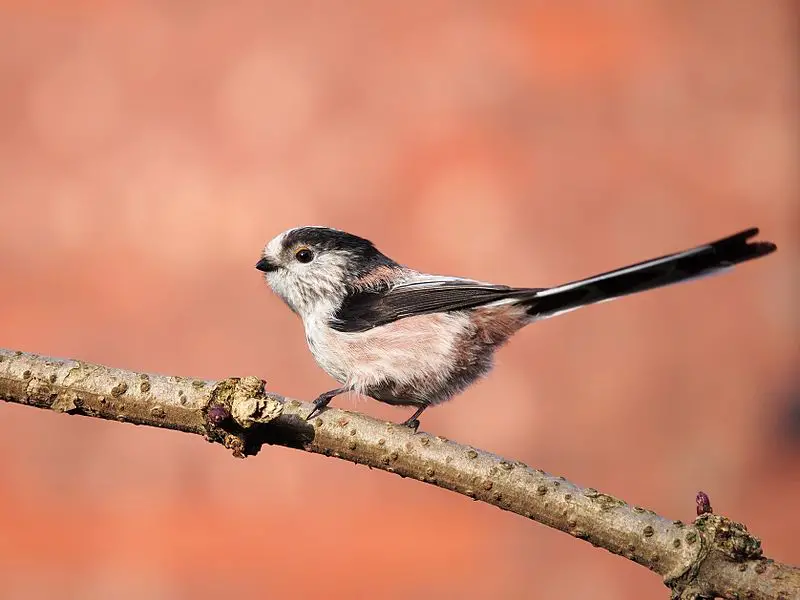
Long-tailed tits are a small passerine bird family with long tails compared to their size. They have 13 species in 3 genera, and they mostly live in Eurasia.
These birds love to stay active by foraging for insects among shrubs and trees throughout the day.
During non-breeding season, these birds can be found living together in large flocks of up to 50 individuals.
These playful little creatures make wonderful companions due to their social nature and cheerful personalities.
Their bright plumage also adds a beautiful splash of colour wherever they go.Scientific classification:
| Kingdom | Animalia |
| Phylum | Chordata |
| Class | Aves |
| Order | Passeriformes |
| Superfamily | Sylvioidea |
| Family | Aegithalidae Reichenbach, 1850 |
33. Penduline Tits

Penduline tits are small passerines with a length ranging from 7.5 to 11 cm, resembling true tits (Paridae). They have delicate bills with needle-like points and their wings appear short and rounded.
These birds build elaborate bag nests that hang from trees over water, giving them the name of “penduline” – meaning hanging. As for diet, they mainly feed on insects and spiders but may also consume some seeds too.
Depending on the species, penduline tits can be found in sub-Saharan Africa or across Eurasia into China and Central Asia as well as parts of North America such as California’s Sierra Nevada range halfway up Mexico’s western coast.Scientific classification:
| Kingdom | Animalia |
| Phylum | Chordata |
| Class | Aves |
| Order | Passeriformes |
| Infraorder | Passerida |
| Family | Remizidae Olphe-Galliard, 1891 |
34. Treecreepers

Treecreepers are small passerine birds found in wooded areas of the Northern Hemisphere and sub-Saharan Africa.
They have dull colored plumage, long curved bills, stiff tails and strong feet that help them to climb up tree trunks while searching for food such as insects and spiders.
The two genera Certhia and Salpornis include eleven species which can be identified by their distinct call – a high pitched ‘tsee-tsit’.
Treecreepers build cup shaped nests on trees usually near the base or middle trunk using mosses, lichens, grasses with leaves inside them to provide insulation from cold temperatures.
These birds also use bark crevices during winter months when they shelter in groups together against extreme weather conditions.Scientific classification:
| Kingdom | Animalia |
| Phylum | Chordata |
| Class | Aves |
| Order | Passeriformes |
| Superfamily | Certhioidea |
| Family | Certhiidae Leach, 1820 |
35. Pallas’s Sandgrouse

Pallas’s sandgrouse is a medium to large bird in the sandgrouse family and named after German zoologist Peter Simon Pallas. It was first mentioned by Marco Polo around 1300 as Bargherlac, from Turkmen bağırlak.
Its scientific name, Syrrhaptes paradoxus (S. pallasii), comes from Ancient Greek words meaning ‘paradoxical plover’.
This species has several distinctive features: it prefers open habitats with sparse vegetation.
Its wings are short but powerful for fast flight; and males have special feathers on their belly that can soak up water which they later transfer to chicks or other members of the flock via special tongue movements.
These fascinating birds are an important part of our natural history and should be appreciated for all they bring us.Scientific classification:
| Kingdom | Animalia |
| Phylum | Chordata |
| Class | Aves |
| Order | Pterocliformes |
| Family | Pteroclidae |
| Genus | Syrrhaptes |
| Species | S. paradoxus |
36. Cetti’s Warbler

Cetti’s warbler is a small, brown bush-warbler that breeds in southern and central Europe, northwest Africa and the east Palearctic.
It has skulking habits which make it difficult to see but its beautiful song can still be heard throughout these regions.
The bird was named after 18th century Italian zoologist Francesco Cetti due to his research on this species of warblers.
This hardy little bird lives in dense vegetation near marshes, wetlands and other water bodies such as riversides or lakeshores where they feed mostly on insects during their breeding season from April till August.
Despite being shy around humans once accustomed to them they are known to be quite friendly with people who visit their habitat regularly.Scientific classification:
| Kingdom | Animalia |
| Phylum | Chordata |
| Class | Aves |
| Order | Passeriformes |
| Family | Cettiidae |
| Genus | Cettia |
| Species | C. cetti |
37. Eurasian Scops Owl

The Eurasian scops owl is a small bird in the Strigidae family. It’s breeding range stretches from southern Europe to Southern Siberia and into western Himalayas.
During winter, it migrates south of the Sahara Desert in Africa. This species was formally described by Swedish naturalist Carl Linnaeus back in 1758.
They have ear tufts on their head which are actually feathers used for camouflage among tree branches; they also provide visual communication between other owls nearby – an important part of survival.
The Eurasian Scops Owl typically eats insects such as crickets, beetles and moths found around its habitat.
These birds make sure that our environment stays balanced with nature by keeping insect populations down.Scientific classification:
| Kingdom | Animalia |
| Phylum | Chordata |
| Class | Aves |
| Order | Strigiformes |
| Family | Strigidae |
| Genus | Otus |
| Species | O. scops |
38. Old World Orioles

Old World orioles are a family of passerine birds found in the Old World. It comprises four genera: piopios, figbirds, pitohuis and the original genus Oriolus.
The African black-headed species have sometimes been removed from this latter group due to their distinct characteristics as well as other proposed splits for Oriolus.
These colorful birds can be identified by their bright yellow or orange plumage that often features darker markings on wings and head areas, although some species may also display a blue hue or stripes across the body feathers.
They typically feed on insects such as caterpillars and grasshoppers but will supplement with small fruits when available too – making them beneficial additions to gardens.Scientific classification:
| Kingdom | Animalia |
| Phylum | Chordata |
| Class | Aves |
| Order | Passeriformes |
| Superfamily | Orioloidea |
| Family | Oriolidae Vigors, 1825 |
39. Shrike

Shrikes are small passerine birds of the family Laniidae, with 34 species in four genera. They get their name from Old English word “scrīc”, which refers to their shriek-like call.
These birds have earned the nickname ‘butcherbirds’ due to their feeding habits; they impale prey on thorns or barbed wire fences for later consumption.
Shrikes also tend to be aggressive predators and hunt a wide range of animals such as insects, small reptiles, rodents and even other smaller bird species.
In terms of physical appearance, these songbirds can vary greatly depending on the specific genus but usually boast a large hooked bill atop an impressive crest along with bright colors like gray, black or brownish hues across its feathers.
It’s clear shrike is quite remarkable creature that has gained notoriety for both hunting prowess and distinctive vocalizations.Scientific classification:
| Kingdom | Animalia |
| Phylum | Chordata |
| Class | Aves |
| Order | Passeriformes |
| Superfamily | Corvoidea |
| Family | Laniidae Rafinesque, 1815 |
40. Sylviid Warblers

The Sylviid warblers are a family of passerine birds found in Eurasia and Africa. They include the typical warblers as well as babblers that were formerly part of the Old World babbler family.
These birds have slender bodies, pointed wings, long tails and strong legs adapted for ground-dwelling habits like running or hopping along branches.
The male often has bright colors while females are usually duller in coloration with more muted plumage patterns than males.
Some species also show sexual dimorphism where one sex may be larger or smaller than its counterpart; for instance some species may have longer tail feathers on the female side compared to their male counterparts.
Many members of this group feed on insects but some specialize on seeds, fruits, nectar or even frogs.Scientific classification:
| Kingdom | Animalia |
| Phylum | Chordata |
| Class | Aves |
| Order | Passeriformes |
| Superfamily | Sylvioidea |
| Family | Sylviidae Leach, 1820 |
41. Dippers

Dippers are a unique group of passerine birds in the family Cinclidae. They are easily recognized by their bobbing or dipping movements and ability to swim and dive underwater.
These small, plump-bodied birds can be found along fast-flowing streams, rivers and lakes throughout Europe, Asia and North America. Dippers feed on aquatic insects which they find under rocks or vegetation at the bottom of water bodies.
During winter months when food is scarce these resourceful birds often resort to eating eggs from other bird’s nests.
Their remarkable agility allows them to brave icy waters without difficulty; dippers have been spotted foraging below thick layers of ice.
Despite their tiny size, these intrepid little creatures make an unforgettable impression with their boldness and determination – truly inspiring avian adventurers.Scientific classification:
| Kingdom | Animalia |
| Phylum | Chordata |
| Class | Aves |
| Order | Passeriformes |
| Superfamily | Muscicapoidea |
| Family | Cinclidae Sundevall, 1836 |
| Genus | Cinclus Borkhausen, 1797 |
42. Skuas

Skuas are a group of predatory seabirds with seven species, all belonging to the genus Stercorarius.
They are also known as “Jaegers” in North America and their name originates from the Faroese word for Great Skua – skúgvur.
These birds typically inhabit coastal areas or open oceans where they feed on fish, krill and other marine creatures.
Skuas can be distinguished by their pointed wings which help them fly long distances while hunting food.
Their distinctive colouration varies depending on age and habitat but generally includes greyish brown upperparts and white underparts with black streaks along its belly area.
The overall size ranges from 24-40 cm making these one of the larger sea bird species.Scientific classification:
| Kingdom | Animalia |
| Phylum | Chordata |
| Class | Aves |
| Order | Charadriiformes |
| Suborder | Lari |
| Family | Stercorariidae Gray, 1871 |
| Genus | Stercorarius Brisson, 1760 |
43. White-Tailed Eagle

The white-tailed eagle is an impressive species of sea eagle found across temperate Eurasia. This majestic bird belongs to the family Accipitridae, which includes hawks, kites and harriers.
It has a wingspan of up to 2.5 meters and can weigh 4 kilograms or more.
The plumage varies in colour from dark brown above with paler head and neck while its tail is pure white – hence it’s name.
They feed mainly on fish but will also take small mammals, birds and carrion when available.
White-tailed eagles are solitary by nature but form pairs during nesting season typically near bodies of water such as lakes or coasts where they build large stick nests on trees or cliffsides for their young ones to hatch safely in peace.Scientific classification:
| Kingdom | Animalia |
| Phylum | Chordata |
| Class | Aves |
| Order | Accipitriformes |
| Family | Accipitridae |
| Genus | Haliaeetus |
| Species | H. albicilla |
44. Panuridae
Little grebes, also known as dabchicks, are small water birds native to temperate and subtropical regions of Europe, Asia and Africa.
These plump little birds have short necks, round heads with bright eyes and long toes that help them swim through the water rapidly.
Their plumage is dull grey-brown on top and white underneath; they are adorned with a distinctive black stripe across their throats.
In addition to being able to fly well underwater in search of prey such as fish or aquatic insects, these vocal creatures make loud trilling noises both during courtship displays or when defending territory from intruders.
They breed near freshwater bodies like ponds, lakes marshes in reed beds by constructing floating nests using vegetation anchored together with mud collected from the bottom of shallow waters.
Little grebes can often be seen swimming low over the surface of stillwater looking for food – a sight sure to delight any bird lover.
45. Stone-Curlew

Stone-curlews, also known as dikkops or thick-knees, are a family of birds that have adapted to live in tropical and temperate regions throughout the world.
They can be found in Africa, Asia and Australia with two or more species per region. Despite being classified as waders, most prefer dry arid habitats over moist wetlands.
Stone-curlews typically have long legs which help them navigate through their preferred terrain efficiently; some species even stand at an impressive height when standing on those long legs.
Additionally they feature cryptic plumage which helps them blend into their surroundings while hunting for prey such as insects and small mammals like rodents.
These unique bird’s calls are easily recognizable; it has been said that hearing one is similar to listening to someone whistling ‘Keee Weee’.Scientific classification:
| Kingdom | Animalia |
| Phylum | Chordata |
| Class | Aves |
| Order | Charadriiformes |
| Suborder | Chionidi |
| Family | Burhinidae Mathews, 1912 |
46. Bustard

Bustards are large, terrestrial birds that inhabit dry grassland areas and the steppes of the Old World. They range from 40-150 cm in length and belong to the family Otididae.
Bustards have an omnivorous diet consisting of leaves, buds, seeds, fruit as well as small vertebrates and invertebrates.
These birds usually live a solitary life but can be seen gathering around water sources or food during certain times of year such as mating season.
Due to their large size they are vulnerable to predation by foxes or other animals which is why they tend to remain alert at all times.
When in open spaces while relying on camouflage for protection against predators when out in tall vegetation coverings.Scientific classification:
| Kingdom | Animalia |
| Phylum | Chordata |
| Class | Aves |
| Clade | Otidimorphae |
| Order | Otidiformes Wagler, 1830 |
| Family | Otididae Rafinesque, 1815 |
47. Threskiornithidae

Threskiornithidae is a family of large wading birds which includes 36 species. These birds are traditionally divided into two subfamilies – the ibises and the spoonbills.
However, recent genetic analysis has shown that spoonbills actually belong to Old World ibis group, while New World ibises form an early offshoot from this lineage.
Threskiornithidse members have long curved beaks with serrated edges used for catching fish in shallow water or mudflats, as well as other aquatic invertebrates like crustaceans and mollusks.
They also feed on plant matter such as grains and seeds found close to wetlands areas where they live.
This diverse diet makes them important scavengers in their ecosystems, helping maintain healthy populations of native wildlife by controlling insect numbers and dispersing energy-rich seeds throughout wetland habitats.Scientific classification:
| Kingdom | Animalia |
| Phylum | Chordata |
| Class | Aves |
| Order | Pelecaniformes |
| Suborder | Ardei |
| Family | Threskiornithidae Richmond, 1917 |
48. Plovers
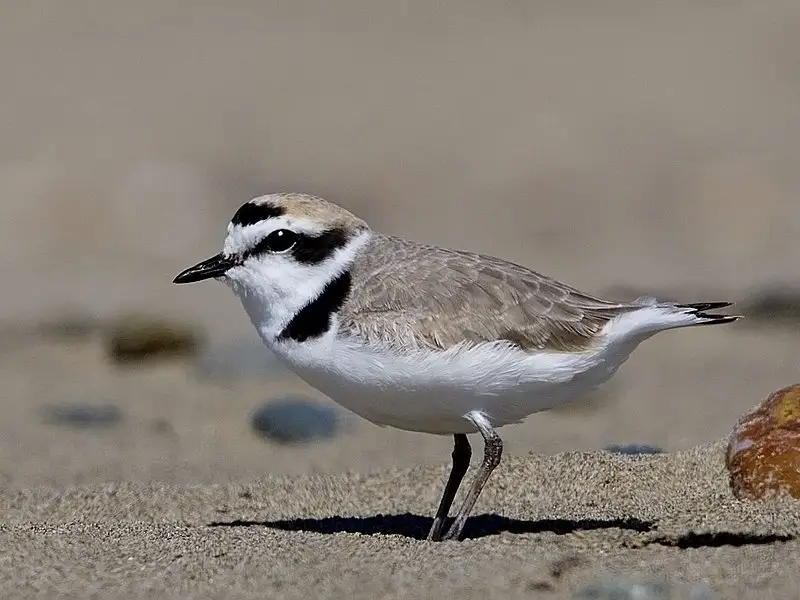
Plovers are a family of around 64-68 species of ground-dwelling birds, commonly found in open country such as fields, meadows and tundras.
They have short bills with webbed feet to help them forage through mud or shallow water.
Plover plumage is usually mottled brown though some species may have brighter colors on the head and wings.
These birds feed mainly on insects but can also eat small crustaceans and worms.
Plovers breed during springtime when they dig holes in sandy or pebbled beaches to lay their eggs which hatch after about 3 weeks incubation period.
They use distraction display behaviour by pretending an injury to the predators away from their nests if needed for protecting their young ones.Scientific classification:
| Kingdom | Animalia |
| Phylum | Chordata |
| Class | Aves |
| Order | Charadriiformes |
| Family | Charadriidae Leach, 1820 |
49. Stilts And Avocets

Stilts and avocets are two distinct groups of birds belonging to the family Recurvirostridae. They range in length from 30-46 cm (12-18 inches) and weigh between 140 – 435 g (4.9 – 15.3 ounces).
Males usually have slightly larger bodies than females, with long thin legs, necks and bills.
Avocet bills curve upwards uniquely while stilt beaks remain straight most times.
These wading birds live mainly near shorelines or wetlands where they feed on aquatic invertebrates like brine shrimp, insects etc., occasionally supplementing their diet with seeds or small fish too.
Stilts also inhabit open fields in search of food sources such as earthworms or grasshoppers during the non-breeding season.
Both groups migrate over large distances for warmer weathers when it gets cold outside.Scientific classification:
| Kingdom | Animalia |
| Phylum | Chordata |
| Class | Aves |
| Order | Charadriiformes |
| Suborder | Charadrii |
| Family | Recurvirostridae Bonaparte, 1854 |